Well drilling methods
A person who cares about health is interested in using natural water. But not everywhere you can dig a well to get water of normal quality and with a flow rate that does not depend on seasonality. Output - well drilling. And this thing is not easy and not cheap. The main requirements for the well is durability and reliability, the necessary supply of drinking water. The result depends on the method of drilling.
In the construction of wells two methods of drilling are applicable: rotary and impact. Rotational drilling method - the destruction of rocks by continuous rotation with the application of the load on the axis of the tool destroying the rock. This method is divided into rotary, core and auger drilling.
Rotary method
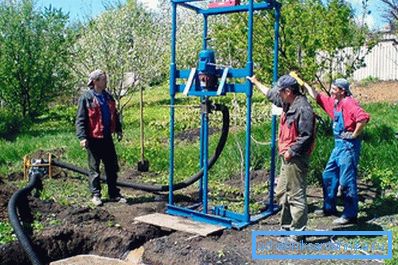
The rotor method is used most often. The rotor rotates the drilling tool. Removal of rock from the face is carried out with a clay mortar. It is pumped into the well along the drill string (direct flushing), and the rock is carried through the wellbore. Or the solution is fed through it, and then the destroyed rock is removed through a backwash. Advantages of the rotary method:
- high drilling rate;
- drilling in rocks with different hardness and at different depths;
- minimum metal intensity of the well, since its walls are fixed with one casing.
Along with the advantages there are disadvantages:
- An aquifer depletion is required to obtain a normal flow rate;
- while drilling water and high-quality clay are needed;
- the difficulty of drilling in rocks with strong water absorption and with boulder-pebble inclusions;
- difficulty in drilling in winter with sub-zero temperatures.
This method is recommended for drilling in rocks with different hardness and with a well-studied geological and hydrological section for the opening of previously explored aquifers.
Kolonkovy and screw method
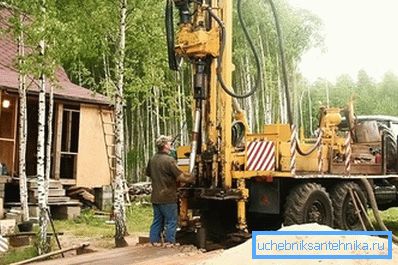
Core drilling is used for the construction of shallow and exploration wells, due to the small diameter of the drilling. When the drill rotates, the crown destroys the rock only around the ring, inside of which the column of this rock (core) remains.
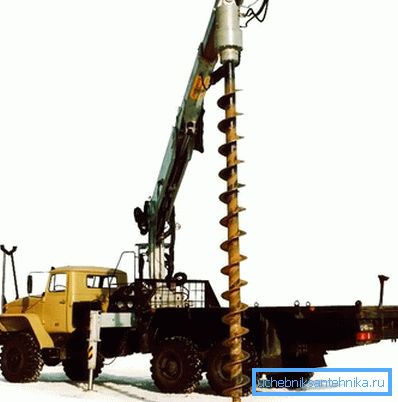
The difference between auger drilling and the previous method is the process of destruction of rock from the face. For its transportation to the top a spiral auger is used. This method of drilling is used in soft rocks and with a depth of wells up to 50 m. Minus - it is impossible to drill in this way in muds or water-saturated sands.
Shock technique
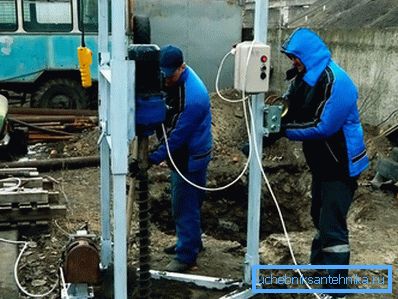
Impact drilling is the destruction of rock by blows of the bit, which periodically rises and falls above the face. Removal of rock from the face is done with the help of a bitch. Shot-rope method of drilling to the 40s. was the main method, but later it was replaced by the rotor. Its disadvantages are:
- high metal intensity of the well due to the high consumption of casing;
- low drilling rate;
- the drilling depth limit is up to 200 m.
Advantages of the shock-cable drilling method:
- high-quality dissection of aquifers;
- the ability to accurately establish a geological section;
- high water flow rate from the well;
- copes with drilling in water-absorbing rocks and in boulder-pebble sediments.
The use of the shock-cable method is justified in areas with poorly studied hydrogeological conditions, when opening and penetrating aquifers of any thickness and in places where it is not possible to use the washing solution, when drilling with an initial diameter of more than 500 mm.
Well Construction

For arrangement of the well at the site often used rotational method - auger, less rotary or core drilling method. Drilling rig can not always call on the site, especially to deploy the drilling rig. The screw method does not require large installations, and with a small depth and diameter it can be produced manually.
Manually drilled in soft rocks, gradually drilling into the face. If you drill from one pass at once to a greater depth, then it will be problematic to get the auger. To facilitate the work, clay or water is gradually poured into the face.
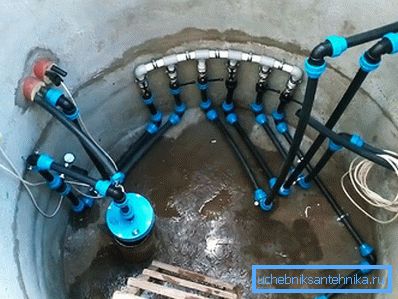
The depth of manually drilled wells is small and reveals upper aquifers that do not have a good flow rate. It is realistic to make a well on your own, but for reliable and long-term operation it is better to contact specialists
Maybe you will be interested in familiarizing yourself with such topics:
- How to legitimize a water well?
- How to choose a pump for the well?
- How to clean a well?
- How to insulate the well for the winter?
Video
Maybe you will be interested in watching a video about drilling methods and well construction: